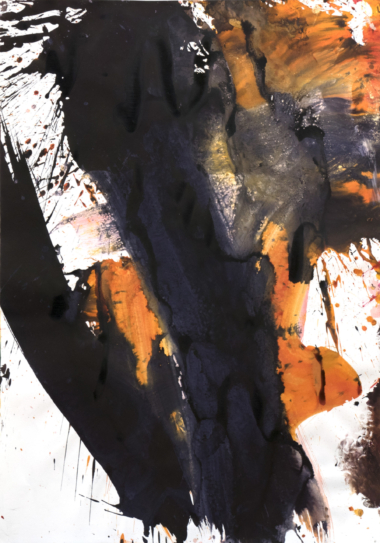Franz GRABMAYR was born in 1927 on the Pfaffenberg in Obervellach (Carinthia) and trained as an apprentice. The exhibition “Young Carinthian Talents” in Klagenfurt, in which he participated in 1952, awakened in him the desire for professional training. In 1954 he began studying at the Academy of Fine Arts in Vienna under Prof. R. C. Andersen and Herbert Boeckl. In 1962 he gave up his teaching profession and from then on worked as a freelance artist. Starting in 1964, he created large-format landscape paintings and, from the mid-1960s, the legendary sand pit paintings, and later the series of “Tanzblätter” (“Dance Sheets”). In 1964 Grabmayr moved into a wing of the vacant Renaissance castle Rosenau. From 1966 to 1971, he preferred to paint in a nearby sand pit. In 1973 Franz Grabmayr moved to Oberstrahlbach near Zwettl. The artist spent the winters in his studio in the Karl-Marx-Hof in Vienna. In 1981, he came up with the idea of a traveling workshop. In the 1980s, the Sand Pit artist worked on night and fire paintings. Impressive scenes with dancers around a campfire, which Grabmayr staged on his Lower Austrian farm, were captured on canvases. In 1984, Franz Grabmayr was awarded the title of professor. In 1997, the artist returned to the Waldviertel. In summer he worked in the Uttissenbach in the Waldviertel and in winter in his studio in Vienna. In 2002, on the occasion of his 75th birthday, his life’s work up to that time was presented at the Österreichische Galerie im Oberen Belvedere in Vienna. In the masses of color wildly applied to the picture supports, the elements of water, fire, sky and earth appear again and again. Franz Grabmayr found inspiration for his expressive, powerful works in nature. The artist passed away in Vienna on May 8, 2015. 2004 – first exhibition in the gallery Welz.
Franz GRABMAYR was born in 1927 on the Pfaffenberg in Obervellach (Carinthia) and trained as an apprentice. The exhibition “Young Carinthian Talents” in Klagenfurt, in which he participated in 1952, awakened in him the desire for professional training. In 1954 he began studying at the Academy of Fine Arts in Vienna under Prof. R. C. Andersen and Herbert Boeckl. In 1962 he gave up his teaching profession and from then on worked as a freelance artist. Starting in 1964, he created large-format landscape paintings and, from the mid-1960s, the legendary sand pit paintings, and later the series of “Tanzblätter” (“Dance Sheets”). In 1964 Grabmayr moved into a wing of the vacant Renaissance castle Rosenau. From 1966 to 1971, he preferred to paint in a nearby sand pit. In 1973 Franz Grabmayr moved to Oberstrahlbach near Zwettl. The artist spent the winters in his studio in the Karl-Marx-Hof in Vienna. In 1981, he came up with the idea of a traveling workshop. In the 1980s, the Sand Pit artist worked on night and fire paintings. Impressive scenes with dancers around a campfire, which Grabmayr staged on his Lower Austrian farm, were captured on canvases. In 1984, Franz Grabmayr was awarded the title of professor. In 1997, the artist returned to the Waldviertel. In summer he worked in the Uttissenbach in the Waldviertel and in winter in his studio in Vienna. In 2002, on the occasion of his 75th birthday, his life’s work up to that time was presented at the Österreichische Galerie im Oberen Belvedere in Vienna. In the masses of color wildly applied to the picture supports, the elements of water, fire, sky and earth appear again and again. Franz Grabmayr found inspiration for his expressive, powerful works in nature. The artist passed away in Vienna on May 8, 2015. 2004 – first exhibition in the gallery Welz.










Recent Comments